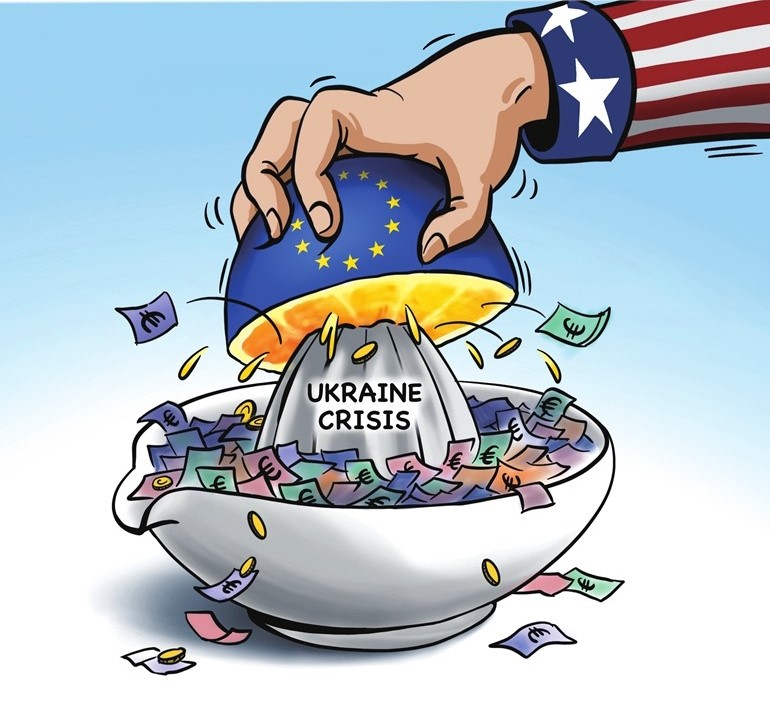Your cart is currently empty!

The Ukraine Narrative is a Lie
The prevailing narrative surrounding the conflict between Russia and Ukraine is often framed through the lens of Russian territorial ambitions. Russia’s actions are seen as an attempt to reclaim territories lost following the collapse of the Soviet Union, drawing parallels to China’s “one-China” policy regarding Taiwan. This narrative is extensively promoted to paint Russia’s motives as imperialistic. The situation in Ukraine is far more complex than the mainstream narrative suggests.
The Revolution of Dignity
The 2014 Revolution of Dignity; evidence suggests that this revolution was not entirely organic but was significantly influenced and possibly orchestrated by Western intelligence agencies. The swift removal of Ukraine’s Moscow-friendly president, Viktor Yanukovych, and the subsequent shift towards Western alliances, aligns too conveniently with U.S. strategic interests.
Yanukovych’s decision to reject a political association and free trade agreement with the EU, opting instead for closer ties with Russia, triggered the protests. According to the Wikipedia article on the Revolution of Dignity, “The scope of the protests widened, with calls for the resignation of Yanukovych and the Azarov government” due to perceived government corruption and Russian influence. However, the speed and scale of the protests suggest a level of coordination beyond spontaneous public outrage.
The Role of Western Intelligence
The involvement of Western intelligence agencies in Ukraine is not a conspiracy theory but a plausible reality supported by historical precedents. The CIA has a long history of orchestrating coups and supporting insurgencies to further U.S. interests globally. Some notable examples include:
- Iran 1953: The CIA orchestrated the overthrow of Prime Minister Mohammad Mossadegh to reinstate the Shah, ensuring control over Iranian oil.
- Guatemala 1954: A CIA-led coup ousted President Jacobo Árbenz, who had nationalized land owned by the United Fruit Company.
- Chile 1973: The CIA supported the military coup that overthrew democratically elected President Salvador Allende, leading to the dictatorship of Augusto Pinochet.
- Nicaragua 1980s: The U.S. funded and armed the Contras in an effort to overthrow the Sandinista government.
Ukraine’s strategic location and resources made it a prime target for such interventions. The narrative of a democratic uprising conveniently distracts from the realpolitik at play. By presenting the conflict as a struggle for freedom against Russian aggression, Western media obscures the underlying motives of maintaining U.S. hegemony and economic interests. The removal of Yanukovych and the installation of a pro-Western government served U.S. strategic goals, aligning Ukraine more closely with NATO and the EU.
The Azov Battalion and Ukraine’s Unresolved Neo-Nazi Ties
The Azov Battalion, a unit within Ukraine’s National Guard, as well as factions of the Ukrainian military and organized elements within its society has well-documented ties to neo-Nazi ideology. Despite this, it continues to receive funding and support from Western nations. The Congressional Record from June 2015 explicitly recognized the Azov Battalion as a neo-Nazi organization, yet in January 2016, Congress removed the ban on funding such organizations abroad. Ignoring these ties does not change the reality that funding Azov equates to funding neo-Nazis. This support undermines the moral high ground claimed by Western nations and raises significant ethical concerns.
The Crimean Annexation and Donbas Conflict
Russia’s annexation of Crimea and the ongoing conflict in the Donbas region are often cited as examples of Russian aggression. However, these actions can also be viewed as responses to Western encroachments. The Crimean referendum, where a majority voted to join Russia, and the Donbas and Luhansk referendums for independence, reflect local sentiments that challenge the Western narrative.
Following the 2014 unrest, Donbas and Luhansk regions voted to secede from Ukraine and formally requested assistance from Russia. As detailed in the Russian People’s Militias in Ukraine article, the separatist movements were supported by local militias, highlighting a complex interplay of local and international interests. These actions, recognized by Russia, underscore the local desire for autonomy and alignment with Russia, complicating the Western portrayal of these events.
The Geopolitical Prize: Crimean Oil Fields
At the heart of the conflict lies a significant geopolitical prize: the Crimean oil fields. Control over these resources is crucial for economic and strategic reasons. By eliminating Russia’s access to these oil fields, the U.S. and its allies can weaken Russia’s energy dominance in Europe, thereby reducing Europe’s dependency on Russian energy.
This strategy is reminiscent of U.S. interventions in the Middle East, particularly in Iraq. The invasion of Iraq in 2003, under the pretext of eliminating weapons of mass destruction, ultimately secured U.S. control over significant oil reserves. Similarly, in Ukraine, the control over the Crimean oil fields serves to bolster U.S. economic interests and ensures that these resources remain under Western influence rather than Russian.
Timeline of Key Events
- November 2013: Yanukovych rejects an EU association agreement, opting for closer ties with Russia.
- February 2014: The Revolution of Dignity leads to Yanukovych fleeing Ukraine.
- March 2014: Crimea holds a referendum, and the majority votes to secede from Ukraine.
- May 2014: Donbas and Luhansk hold referendums, voting to secede from Ukraine and the Ukrainian Civil War begins.
- June 2015: Congress recognizes Azov Battalion as a Neo-Nazi Organization.
- January 2016: Congress Removes Ban on Funding Neo-Nazi Organizations Abroad
- February 2022: Russia recognizes the vote for independence of the Donbas and Luhansk regions and accepts their request for direct assistance
- August 2022: Donbas and Luhansk regions vote to join Russia
The Real Beneficiaries: Corporate and Elite Interests
The continuous support for Ukraine by Western nations, including military aid and economic sanctions against Russia, raises questions about who truly benefits from this conflict. It’s evident that the primary beneficiaries are not the Ukrainian or American working class but the military-industrial complex and the corporate elites.
The prolonged conflict serves to justify increased defense spending and consolidates corporate control over strategic resources. This diversion of public funds towards military expenditures and away from social programs exacerbates economic inequalities, leaving ordinary citizens to bear the brunt of geopolitical power plays.
Read More
- Why is Russia Invading Ukraine?
- Russia’s Attempt to Reclaim Territory
- Revolution of Dignity
- War in Donbas (2014–2022)
- Separatists Vote to Split from Ukraine
- Crimeans Vote to Join Russia
- Ukraine Crisis and the War in Odessa
- Russian People’s Militias in Ukraine
- Congressional Record Recognizing Azov Battalion
- Congress Removes Ban on Funding Neo-Nazis
- Donbas Votes to Join Russia
- Zaporozhye Referendum
- Regions Vote to Join Russia
- Washington Post on Anti-Kyiv Sentiment
- Donbas Requests Russian Assistance
- 2014 Donbas Status Referendums
- Luhansk Referendum on Joining Russia

Leave a Reply